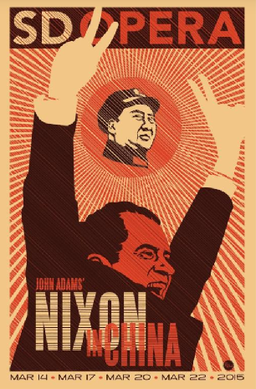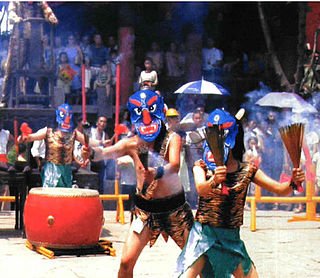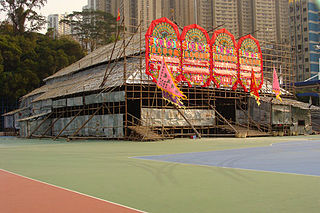External links
Video
Chinese opera and Chinese narrative traditions | |
|---|---|
| Dramatic theater | |
| Religious theater | |
| Comedic/Light theater | |
| Quyi (narrative) | |
| Historical | |
| Role types | |
| Costumes | |
| Related topics | |
| Pu opera | |||||||
|---|---|---|---|---|---|---|---|
| Native name | Puju | ||||||
| Etymology | From Pu Prefecture (Puzhou) | ||||||
| Other names | Puzhou clapper opera | ||||||
| Chinese | 蒲 州 梆 子 | ||||||
| Hanyu Pinyin | Púzhōu bāngzǐ | ||||||
| Major region | Southern Shanxi (area around Yuncheng) | ||||||
| Typical instruments | |||||||
| Topolect | Mandarin Chinese (Central Plains Mandarin) | ||||||
| Tune system | Bangzi | ||||||
| Chinese name | |||||||
| Traditional Chinese | 蒲 劇 | ||||||
| Simplified Chinese | 蒲 剧 | ||||||
| |||||||
Pu opera, also known as Puzhou clapper opera, is a variety of Chinese opera from southern Shanxi, China. It is closely related to qinqiang .
It is a very old art form, and makes use of very wide linear intervals.

Turandot is an opera in three acts by Giacomo Puccini, posthumously completed by Franco Alfano in 1926, and set to a libretto in Italian by Giuseppe Adami and Renato Simoni.

Chaozhou, alternatively Chiuchow, Chaochow or Teochew, is a city in the eastern Guangdong province of China. It borders Shantou to the south, Jieyang to the southwest, Meizhou to the northwest, the province of Fujian to the east, and the South China Sea to the southeast. It is administered as a prefecture-level city with a jurisdiction area of 3,110 km2 (1,200 sq mi) and a total population of 2,568,387. Its built-up area encompassing most of Shantou and Jieyang cities was home to 12,543,024 inhabitants on 13 local administrative areas. Along with Shantou and Jieyang, Chaozhou is a cultural center of the Chaoshan region.

Music of China refers to the music of the Chinese people, which may be the music of the Han Chinese in the course of Chinese history as well as ethnic minorities in today's China. It also includes music produced by people of Chinese origin in some territories outside mainland China using traditional Chinese instruments or in the Chinese language. It includes forms from the traditional and modern, Western inspired, commercial popular music, folk, art, and classical forms, and innovative combinations of them.

Nixon in China is an opera in three acts by John Adams with a libretto by Alice Goodman. Adams's first opera, it was inspired by U.S. president Richard Nixon's 1972 visit to the People's Republic of China. The work premiered at the Houston Grand Opera on October 22, 1987, in a production by Peter Sellars with choreography by Mark Morris. When Sellars approached Adams with the idea for the opera in 1983, Adams was initially reluctant, but eventually decided that the work could be a study in how myths come to be, and accepted the project. Goodman's libretto was the result of considerable research into Nixon's visit, though she disregarded most sources published after the 1972 trip.

Traditional Chinese opera, or Xiqu, is a form of musical theatre in China with roots going back to the early periods in China. It is an amalgamation of various art forms that existed in ancient China, and evolved gradually over more than a thousand years, reaching its mature form in the 13th century, during the Song dynasty (960–1279). Early forms of Chinese theater are simple, but over time various art forms such as music, song and dance, martial arts, acrobatics, costume and make-up art, as well as literary art forms were incorporated to form traditional Chinese opera. Performers had to practice for many years to gain an understanding of the roles. Exaggerated features and colors made it easier for the audience to identify the roles portrayed.

Yiyang is a prefecture-level city on the Zi River in Hunan province, China, straddling Lake Dongting and bordering Hubei to the north. According to the 2010 Census, Yiyang has a population of 4,313,084 inhabitants residing in an area of 12,144 km2 (4,689 sq mi). The previous census was in 2000 when it was recorded there were 4,309,143 inhabitants.

Cantonese opera is one of the major categories in Chinese opera, originating in southern China's Guangdong Province. It is popular in Guangdong, Guangxi, Hong Kong, Macau and among Chinese communities in Southeast Asia. Like all versions of Chinese opera, it is a traditional Chinese art form, involving music, singing, martial arts, acrobatics, and acting.

Peking opera, or Beijing opera, is the most dominant form of Chinese opera, which combines music, vocal performance, mime, dance and acrobatics. It arose in Beijing in the mid-Qing dynasty (1644–1912) and became fully developed and recognized by the mid-19th century. The form was extremely popular in the Qing court and has come to be regarded as one of the cultural treasures of China. Major performance troupes are based in Beijing, Tianjin and Shanghai. The art form is also preserved in Taiwan, where it is also known as Guójù. It has also spread to other regions such as the United States and Japan.

Kunqu, also known as Kunju (崑劇), K'un-ch'ü, Kun opera or Kunqu Opera, is one of the oldest extant forms of Chinese opera. Kunqu is one of the oldest traditional operas of the Han nationality, and is also a treasure of Chinese traditional culture and art, especially opera art. It evolved from the local melody of Kunshan and later came to dominate Chinese theater from the 16th to the 18th centuries. The style originated in the Wu cultural area. It has been listed as one of the Masterpieces of the Oral and Intangible Heritage of Humanity by UNESCO since 2001. Since the mid-Ming Dynasty, Wei Liang Fu has been the sole leader of Chinese opera for nearly 300 years. In 2006, it was listed on the first national intangible cultural heritage list. In 2008, it was included in the List of Representative Works of Intangible Cultural Heritage of Humanity. In December 2018, the General Office of the Ministry of Education announced that Peking University is the base for inheriting excellent traditional Chinese culture in Kunqu.

Huangshan, is a prefecture-level city in southern Anhui Province, People's Republic of China. Huangshan means Yellow Mountain in Chinese and the city is named after the famously scenic Yellow Mountains which cover much of the city's vast geographic expanse. The prefectural city of Huangshan includes three urban districts and four counties. The urban center of Huangshan was originally the city of Tunxi and is now called Tunxi District. Locals still call the city Tunxi to distinguish urban core from other parts of Huangshan.

Theatre of China has a long and complex history. Traditional Chinese theatre, generally in the form of Chinese opera, is musical in nature. Chinese theatre can trace its origin back a few millennia to ancient China, but the Chinese opera started to develop in the 12th century. Western forms like the spoken drama, western-style opera, and ballet did not arrive in China until the 20th century.

Dan is the general name for female roles in Chinese opera, often referring to leading roles. They may be played by male or female actors. In the early years of Peking opera, all dan roles were played by men, but this practice is no longer common in any Chinese opera genre.

Huangmei or Huangmei tone originated as a form of rural folk song and dance that has been in existence for the last 200 years and possibly longer. Huangmei opera is one of the most famous and mainstream opera in China. The original Huangmei opera was sung by women when they were picking tea, and the opera was called the Picking Tea Song. In the late Qing dynasty, the songs came into Anhui Province— Huaining County adjacent regions, combined with the local folk art, Anqing dialect with singing and chants, and gradually developed into a newborn's operas. The music is performed with a pitch that hits high and stays high for the duration of the song. It is unique in the sense that it does not sound like the typical rhythmic Chinese opera. In the 1960s Hong Kong counted the style as much as an opera as it was a music genre. Today it is more of a traditional performance art with efforts of revival in mainland China, Hong Kong, and Taiwan, and mostly sung in Mandarin.

The erxian is a Chinese bowed string instrument in the huqin family of instruments. It has two strings and is used primarily in Cantonese music, most often in "hard string" chamber ensembles. In the 1920s, following the development of the gaohu, the erxian experienced a decline and since the late 20th century has been little used outside the tradition of Cantonese opera.

Shanghai opera, formerly known as Shenqu, is a variety of Chinese opera from Shanghai typically sung in Shanghainese. It is unique in Chinese opera in that virtually all dramas in its repertoire today are set in the modern era. This arose from Yue opera's dominance in Shanghai in the 1940s.
He Saifei is a Chinese actress of film and television, as well as a celebrated Yue opera performer of dan (female) roles. Internationally, she is best known for playing supporting roles in period films like Raise the Red Lantern (1991) and Temptress Moon (1996).

Nuo opera or Nuo drama is one of China's most popular folk operas. Characterized by its special features such as ferocious masks, unique dresses and adornments, the strange language used in performance, and mysterious scenes, Nuo opera has been selected as one of the non-material cultural legacies of China. The opera is a religious performance intrinsic to the culture of Nuoism, a type of Chinese folk religion. The purpose of Nuo opera is to drive away devils, disease and evil influences, and also to petition for blessings from the gods. Singing and dancing are included in Nuo opera and performers wear costumes and masks.

Dance in China is a highly varied art form, consisting of many modern and traditional dance genres. The dances cover a wide range, from folk dances to performances in opera and ballet, and may be used in public celebrations, rituals and ceremonies. There are also 56 officially recognized ethnic groups in China, and each ethnic minority group in China also has its own folk dances. Outside of China, the best known Chinese dances today are the Dragon dance and the Lion dance.

Yue opera, also known as Shaoxing opera, is the second most popular Chinese opera genre. Only Peking opera is more popular nationwide.

Opera with divine powers is a form of Chinese opera played at religious ceremonies including for the gods' birthday, temple opening, at miaohui, ghost festival, Daijiao and traditional festivals, is the play performed to welcome the gods' race, is one of a series of celebrations held by the people to thank the gods and reward them for their blessings. Usually performed at temple fairs or theatres. In Guangdong, it is mostly called Shen Gong Xi, and in China, in the north, it is mostly called She Xi The word "society" was a small unit in the ancient region, and the drama was performed in the society, which was called social drama)。On birthdays where this form of opera is played are those of the gods: Xuanwu, Guan Yu, Dragon King, Mazu, Shanshen, City God and Tudigong.